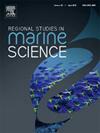Assessment of treatment efficiency and potential marine environmental risk of petrochemical effluents from the GL3-Z Refinery in Arzew, Algeria
IF 2.1
4区 环境科学与生态学
Q3 ECOLOGY
引用次数: 0
Abstract
This study presents a 27-month monitoring (January 2021–March 2023) of treated industrial effluents from the GL3-Z refinery wastewater treatment plant (WWTP) in Arzew, Algeria. A total of 27 samples were analyzed using standard methods to investigate physicochemical parameters from the industrial effluent, including temperature, pH, total suspended solids (TSS), chemical oxygen demand (COD), biochemical oxygen demand over 5 days (BOD₅), phosphate (PO₄³⁻), cyanide (CN⁻) and concentrations of selected heavy metals ions such as Cr(VI), Fe(II), Cu(II), Zn(II). The obtained results were: temperature (15.10–28.13 °C), pH (4.04–5.97), TSS (8.00–272.00 mg/L), COD (15.50–317.33 mg/L), BOD₅ (0.80–108.93 mg/L), PO₄³ ⁻(36.75–103.95 mg/L), Zn(II) (0.037–0.90 mg/L), Fe(II) (0.16–26.30 mg/L), Cr(VI) (0.002–0.18 mg/L), Cu(II) (0.02–25.57 mg/L), and CN⁻ (0.001–0.16 mg/L). The major findings of this research work reveal the ineffectiveness of the treatment system employed by the WWTP in reducing TSS, COD, BOD₅, PO₄³ ⁻, Cu(II), Zn(II), Cr(VI), and CN⁻ levels to comply with the regulatory standards of the Ministry of Land Planning and Environment of Algeria, the World Bank Group, and the Australian and New Zealand Environment and Conservation Council. The results showed that effluents from this WWTP are potential sources of marine pollution and call for urgent improvement of WWTP operations to ensure safe effluent discharge.
阿尔及利亚Arzew GL3-Z炼油厂石化废水处理效率和潜在海洋环境风险评估
本研究对阿尔及利亚Arzew GL3-Z炼油厂废水处理厂(WWTP)处理后的工业废水进行了为期27个月的监测(2021年1月至2023年3月)。使用标准方法分析了总共27个样品,以调查工业废水的物理化学参数,包括温度,pH值,总悬浮固体(TSS),化学需氧量(COD),生化需氧量超过5天(BOD₅),磷酸盐(PO₄³⁻),氰化物(CN⁻)和选定重金属离子如Cr(VI), Fe(II), Cu(II), Zn(II)的浓度。结果是:温度(15.10 - -28.13°C), pH值(4.04 - -5.97),TSS -272.00 (8.00 mg / L),鳕鱼 -317.33 (15.50 mg / L), BOD₅ -108.93 (0.80 mg / L),阿宝₄³ ⁻ -103.95 (36.75 mg / L)、锌(II)(0.037 - -0.90 mg / L),铁(II)(0.16 - -26.30 mg / L),铬(VI)(0.002 - -0.18 mg / L),铜(II)(0.02 - -25.57 mg / L),和CN⁻ -0.16 (0.001 mg / L)。这项研究工作的主要发现揭示了世界污水处理厂采用的处理系统在降低TSS, COD, BOD₅,PO₄³ 毒血症,Cu(II), Zn(II), Cr(VI)和CN毒血症方面的有效性,以符合阿尔及利亚土地规划和环境部,世界银行集团以及澳大利亚和新西兰环境与保护委员会的监管标准。结果表明,该污水处理厂的污水是潜在的海洋污染源,迫切需要改进污水处理厂的操作,以确保污水的安全排放。
本文章由计算机程序翻译,如有差异,请以英文原文为准。
求助全文
约1分钟内获得全文
求助全文
来源期刊

Regional Studies in Marine Science
Agricultural and Biological Sciences-Ecology, Evolution, Behavior and Systematics
CiteScore
3.90
自引率
4.80%
发文量
336
审稿时长
69 days
期刊介绍:
REGIONAL STUDIES IN MARINE SCIENCE will publish scientifically sound papers on regional aspects of maritime and marine resources in estuaries, coastal zones, continental shelf, the seas and oceans.
 求助内容:
求助内容: 应助结果提醒方式:
应助结果提醒方式:


